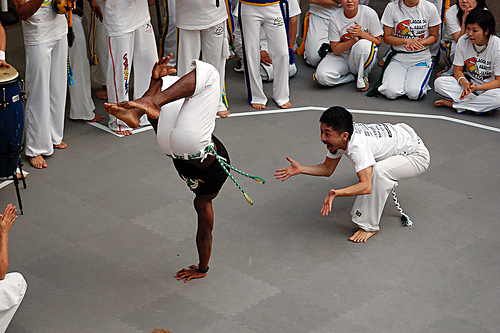
Yo, pictures are up from the Capoeira West 2005 Batizado:
The batizado brought together groups from all over to Japan, allowing the participants to play against players using a variety of styles and techniques. It was fascinating to see the game being played by such high level players, to observe how the balances between trickery, speed, flexibility, acrobatics, and strength affect the mood and pacing of the game.
The coolest thing about this martial art is that if you look at the faces of the participants, almost everyone is wearing a smile and is having a good time. Though sometimes it is appropriate to strike another player and to inflict injury, mostly the participants do not play to hurt each other, and rather just demonstrate moves rather than carry a potentially dangerous kick or sweep to completion.
I?ve been told that you have to be careful when you play with students from other schools, but I?ve only heard and read about ruthlessness in the roda second-hand. From what I’ve seen in Japan, capoeira does not tend to attract the same meatheads, the guys who are out there to prove their manliness by exerting dominance on every one, that other martial arts do.
I often hear people say that capoeira is not effective as a martial art. Then why haven’t we seen people use it in Pride, UFC, or K1? Well, in these venues, other martial arts have an edge. For pit fight situations like these muay thai, jiu-jitsu, shoot fighting, etc… give a fighter the edge. I would also argue that, like Aikido, it takes a lot of time and practice before one can use it to fight proficiently in contrast to the relatively little training it takes someone learning jiu-jitsu before that training can be effectively applied in a real fight situation. But mostly, choosing to engage in such a fight goes against the philosophy of capoeira, which preaches cunning and trickery over brute strength.
Luring an opponent into attacking and then springing a trap when they least expect it is how the capoerista would choose to engage an enemy. For example, he might feign a retreat or a fall to the ground, and then instantly spring back and ambush the attacker with a powerful kick. And if he is at a disadvantage or starts losing the fight, then running away is a completely acceptable option. This is no Cobra Kai approach to life.
Mestre Bimba was once asked “What would you do if someone pointed a gun to your chest?” to which he replied “Then I would die, my son.”. There is no conventional sense of “honor” in this martial art, which was built from the practical knowledge of those who needed to protect themselves and fight outnumbered and outgunned, against all odds. Survival and learning to thrive amid the hardships of life are the values inherent in capoeira.
In Brazil, capoeiristas are known to fight holding razorblades in their hands and between their toes. The lateral shift of the jinga, the use of cartwheels and acrobatics, and the dazzling movements on the ground look a lot more dangerous if you can picture how these graceful movements could be used to slice and dice an unwary opponent. It?s interesting to note that members of the older generation are viewed both as lawless thugs and as protectors against the government and police. Many of them kept the nightsticks of police that they had defeated in street fights as trophies, and one famous capoeirista actually went into police headquarters and returned his sizable collection to them as a taunt (In case you were interested, these accounts were taken from Capoeira: A Brazillian Art Form by Bira Almeida and The Little Capoeira Book by Nestor Capoeira). Now that?s bad ass.


9 Responses to Capoeira West Batizado 2005 Pictures